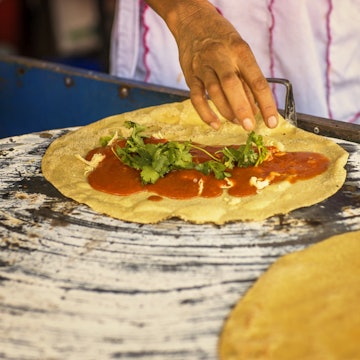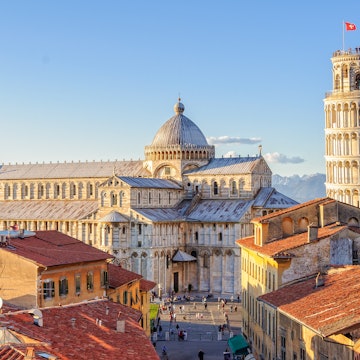

Go on the tapas trail in Spain and find high-quality dishes at places like Quimet & Quimet in Barcelona. Michael Heffernan for Lonely Planet
Food is such a big part of life in Spain, it’s the fabric that threads its way through friendships and family connections. Weekend family lunches, celebratory meals, lively tapas bars filled with groups of friends – eating here is all about sharing time with others. Spaniards love to eat out, and the tradition of the sobremesa, chatting after the meal over a coffee or a digestif, means lunch can often last until 5pm and dinner can last until midnight.
Most people are familiar with tapas and paella, but there is so much more variety to Spanish cuisine, and each region has a unique gastronomic identity to discover.

On the tapas trail
Tapas epitomize Spanish cuisine – its simplicity, its fresh produce and the way it brings people together. Whatever you believe about the origins of tapas, whether they served as lids to cover your drink or they were invented by King Alfonso X when his doctor forbade him from drinking alcohol without eating, they have transformed over time and now take on countless different forms.
Some of the most typical tapas dishes to try include patatas bravas (cubes of fried potato drizzled with a spicy tomato sauce), tortilla de patatas (Spanish omelette with potato), croquetas (deep friend rolls typically filled with cheese and meat) and ensaladilla rusa (potato salad mixed with tuna, boiled egg, carrots and peas). But often it’s the simplest, one-ingredient tapas that are the most popular – a plate of ruby red jamón Ibérico (Iberian cured ham), a platter of Manchego cheese or Padrón peppers fried and sprinkled with sea salt.
Tapas are served everywhere in Spain, but it’s Andalucía that stands above the rest when it comes to these small dishes. There are a few places in Spain that still serve free tapas when you order a drink. Granada is the most famous of these, but cities such as Almería, Jaén and León also continue this practice.
In northern Spain, they’ve perfected their own type of tapas – pintxos. It’s these plus the sheer number of Michelin-starred restaurants that have turned the Basque Country into a top foodie destination. Pintxos are essentially small gourmet bites. Most commonly they feature a couple of traditional ingredients, from shredded spider crab to red pepper filled with cod skewered onto slice of baguette. But today pintxos have morphed into so much more – it could be a miniature bowl of risotto with Idiazabal cheese, stewed beef cheek in red wine, or battered prawns. One of the most famous pintxos is the gilda – an olive, an anchovy and a guindilla pepper skewered on a stick.
Where to try it: El Rinconcillo, the oldest tapas bar in Sevilla, and Borda Berri and Ganbara in San Sebastián for pintxos.

Try paella in its true home of Valencia
Paella is possibly Spain’s most famous and defining dish, found all over the country. But it’s a dish that can be life-affirming if it’s done well and miserable if not. As a general rule of thumb, avoid paella from anywhere that has photos of it displayed outside the restaurant as, more often than not, these places tend to serve paella heated up from frozen. Your best option is to choose an arrocería – a restaurant specializing in rice dishes. Remember paella is seen as a lunchtime meal – you won’t find many Spaniards eating it for dinner.
While paella de mariscos (seafood paella) studded with mussels, clams and prawns has today become the most popular type, the original paella didn’t contain seafood at all. The paella was born in Valencia, in the rice fields on the shores of the Albufera Lagoon. It was made with ingredients that farmers could find in the fields such as butter beans, rabbit, snails and chicken. This is still the traditional paella Valenciana eaten today.
Valencia is still the best region to try paellas and rice dishes of all kinds – from the creamy-like arroz meloso to the crispy arroz a banda. The Valencian city of Alicante has even been nicknamed the City of 1001 Rice Dishes, because there are so many versions you can try there.
Where to try it: Casa Carmela and Levante in Valencia and L’Establiment in El Palmar on the shores of the Albufera Lagoon.

Go big for lunch with a menu del día
The menu del día (menu of the day) has become a big part of Spanish culture since it was first introduced in the 1960s. It typically consists of a starter, main course, dessert or coffee, bread and a drink for a set price. The average cost is around €13 (US$15). It’s important to note that the menu del día offers are only available Monday to Friday lunchtimes (usually between 2pm and 4pm).
This fixed menu was actually introduced by the Franco regime as the menú turístico (tourist menu) in order to showcase the country’s cuisine to visitors and there were strict rules about what it should contain. It has changed somewhat since then, but the classic menus are still very popular. They typically consist of a choice of three or more starters like salad, gazpacho or melon with jamón (ham), followed by a choice of a grilled meat or fish main and then a selection of desserts such as fruit, yogurt or flan (similar to the French crème caramel).
Where to try it: Everywhere.

Slurp Spanish stews across the country
It may not be obvious to visitors, but Spain loves its hearty stews and platos de cuchara (food you eat with a spoon). In fact, almost every region has its own version. Cocido madrileño is Madrid’s signature stew, where the meat, vegetables and chickpeas are served in one dish and the broth in another. The northern region of Asturias is loved for its own version – the fabada Asturiana – made from white beans, pork belly, chorizo and black pudding in rich soup with strands of fragrant saffron.
Then there are the seafood stews – two of the best to try are suquet de peix from Catalonia and marmitako from the Basque Country. The Catalan fisherman’s stew contains a mixture of different fish and seafood with potatoes and almonds, while marmitako uses big chunks of tuna vegetables and white wine.
Where to try it: Lhardy and La Gran Tasca for Cocido Madrileño in Madrid, La Corte de Pelayo and La Tabernilla in Oviedo for Fabada.

Savor seafood delights
Spain is a nation of seafood lovers, and you can’t go anywhere without seeing some type of fish or shellfish on the menu – even when you’re far from the coast. In fact, Madrid offers up some of the best.
Make sure to try gambas al ajillo (garlic shrimps), mejillones (mussels), pescaíto frito (small, battered fish platters in Andalucía), chipirones (squid or baby cuttlefish), Galician pulpo a feira (boiled octopus on a bed of potatoes) and Basque merluza en salsa verde (hake in green sauce).
If you’re in Andalucía over the summer, head to the chiringuitos (beach bars) for some traditional espetos de sardinas (sardine skewers). They’re cooked on open fires on the beach, particularly in Málaga.
Where to try it: Txoko Getaria for harbor-side grilled fish in the Basque Country, Los Diamantes for pescaíto frito in Granada and El Tintero in Málaga.

Go crazy for jamón
Spain is a nation of true carnivores, and there’s no meat that Spaniards go crazy for more than jamón (cured Iberian ham). Jamón is a breakfast food on toast, eaten as a tapa on its own or in croquetas, stuffed in a bocadillo (filled baguette) or sprinkled on salmorejo (a thick cold tomato soup). It’s one of the country’s most prized ingredients and one that unites all regions.
Jamón Ibérico is made exclusively from Iberian pig breeds, while jamón serrano is made from various breeds. There are many different levels of quality, depending on how long it's aged and what the pigs are fed. The best is considered to be the Ibérico de Bellota from the black Iberian pigs that freely roam the dehesa oak forests of Extremadura and live on acorns.
Spain is the EU’s second-largest producer of pork products. Some of the most popular dishes that feature pork are solomillo (pork tenderloin), cochinillo (roast suckling pig), chorizo, longanizas (long sausages), morcilla (black pudding) and carrilleras de cerdo (pork cheek).
Where to try it: The best ham-producing towns are Cáceres, Badajoz, Guijuelo and Huelva.

Sip on glasses of cava, tempranillo and albariño
Spain is the third top wine-producing country in the world, just behind France and Italy, and it’s made throughout the country, including on its islands.
La Rioja is the most famous wine region, spanning 54,000 hectares. It’s known for its full-bodied fruity reds made primarily from tempranillo and garnacha grapes. Ribera del Duero is another popular Spanish wine region in Castile and León, where wines are made almost exclusively with tempranillo grapes.
For white wine lovers, the best areas are Rías Baixas in Galicia with its albariño wines and Rueda in Castile and León, known for its verdejo wines. Albariño wines have notes of citrus fruits, peach and nectarine, while verdejos are light-bodied with a herbal flavor and hints of lemon and fennel.
Spaniards celebrate with cava, a white sparkling wine made from grape varieties such as xarel-lo, macabeu and parellada. It’s produced in the Catalan region of the Penedés.
Jeréz in the southern region of Andalucía is the sherry capital of Spain. The so-called Sherry Triangle lies between Jeréz de la Frontera Sanlúcar de Barrameda and El Puerto de Santa María. The sherries are mainly made from the palomino grape, while the sweeter versions are made with Pedro Ximénez and moscatel.

Find vegetarian and vegan options
Being vegetarian and vegan in Spain can be tough as most dishes are very meat- and seafood-heavy. Even dishes like grilled artichokes will often have pieces of ham or foie gras on the top, so it’s important that you always ask what a dish contains.
In very traditional Spanish restaurants, you may just be offered a salad or a plate of grilled vegetables if you’re vegetarian or vegan. A paella de verduras (vegetable paella) is one of the best main meals you can order.
Some of the best tapas dishes to order without meat and fish are berenjenas con miel (deep-fried aubergine drizzled with molasses) and pimientos de Padrón (fried green peppers). If you eat eggs and dairy, there are a few more options including tortilla de patatas, patatas bravas (which usually come with mayonnaise), and spinach or mushroom croquetas.
There are also two stews that are completely vegetarian – pisto Manchego from Castile-La Mancha (similar to a ratatouille and often topped with a fried egg), and espinacas con garbanzos (a Moorish-inspired spinach and chickpea stew from Andalucía).
The lack of protein and repetitiveness of eating many of these same dishes can get tiresome, so your best option is to go international. Most larger cities in Spain, particularly Madrid, Barcelona, Valencia and Seville, also have specialized vegetarian and vegan restaurants.

A year in food
Spring (March to May)
It's the time of year to try suckling pig and roasted lamb, asparagus and blue fish. Easter favourites such as Mona de Pascua (sweet-bread like cakes), buñuelos (fritters) and torrijas (like French toast) are available in bakeries and supermarkets. Enjoy celebrations including Día del Espárrago (Asparagus Day) in Navarra in April and La Semana Gastronómica del Atún (Tuna Week) at the end of May in Cádiz.
Summer (June to August)
Summer is all about melons, figs, cherries, tomatoes and peppers. Events taking place include the Fiesta del Pimiento (pepper) de Herbón and the Fiesta del Pulpo (octopus), both in Galicia in August. It's also worth checking out Espeto de sardinas (sardine skewers) season on the beaches in Málaga throughout the summer.
Autumn (September to November)
Autumn is a bumper season for tasty vegetables and fruits including chestnuts, mushrooms, sweet potatoes, quince and pomegranates as well as grape and olive harvests. Celebrations include La Castanyada (chestnut festival) celebrated across Catalonia and the O Grove seafood festival in Galicia in October.
Winter (December to February)
The days may be getting shorter but there's still an abundance of seasonal produce like avocados, aubergines, artichokes, citrus fruits and pumpkin. They taste especially delicious at this time of year. More foodie events in winter include the Fiesta de la Aceituna (olive) in Martos, Jaén in February. It’s also calçot (a cross between a sweet spring onion and a leek) season across Catalonia, and many countryside restaurants will be serving special calçotada menus.
















